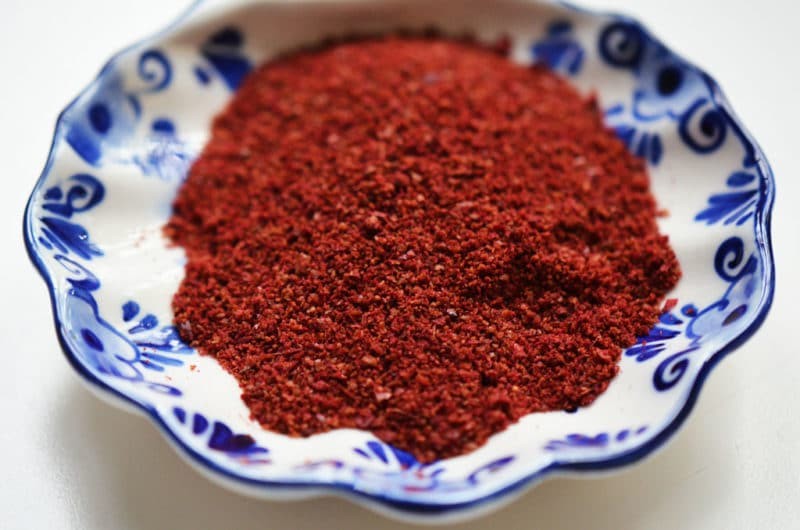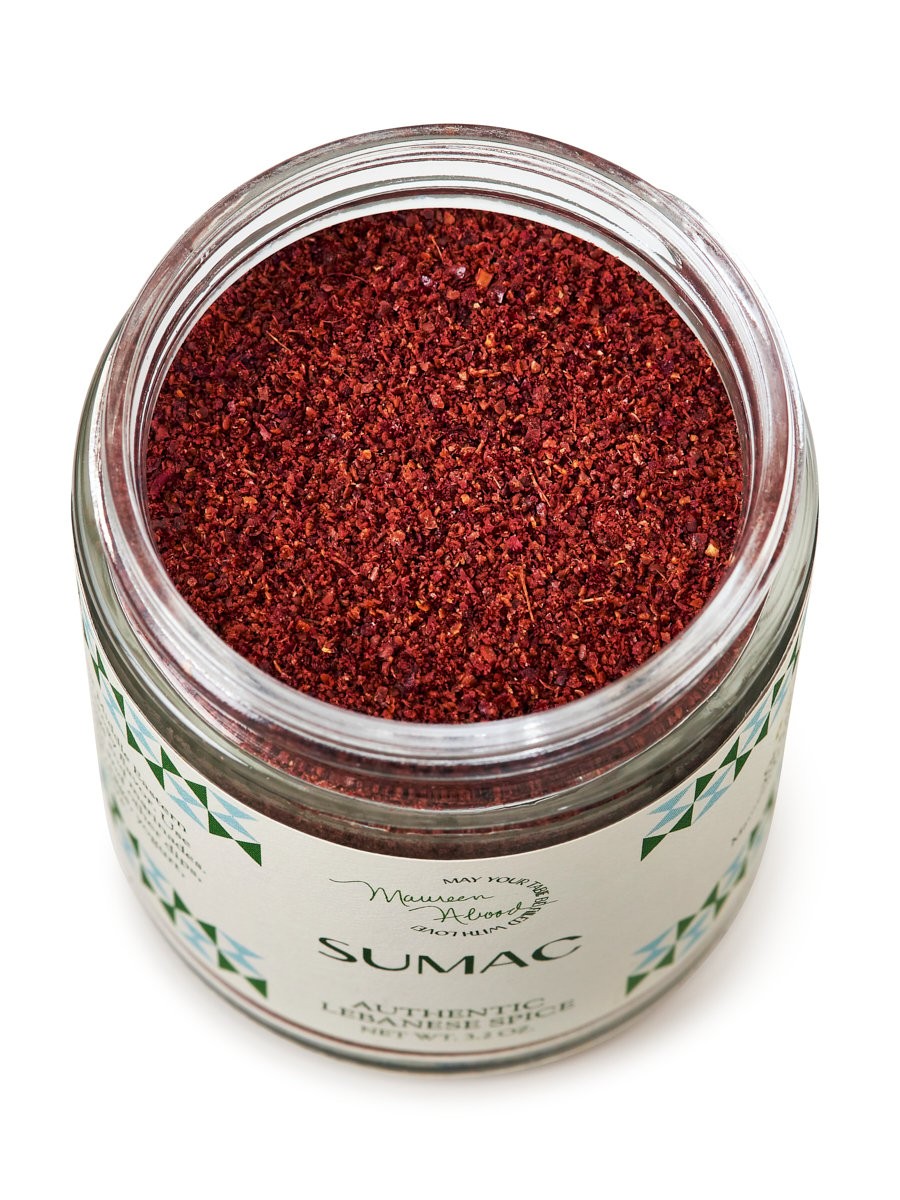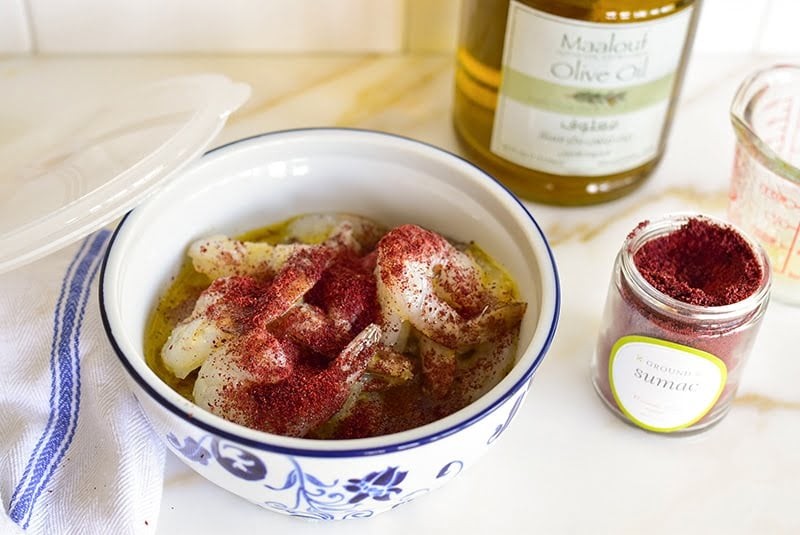What Is Sumac Spice? Sumac spice, a vibrant and versatile ingredient, is made from the dried and ground berries of the sumac plant. Discover its tangy flavor and diverse culinary uses with WHAT.EDU.VN. Explore its health benefits and find out where to buy this unique spice, plus get answers to all your questions about sumac.
1. What Is Sumac Spice? Unveiling the Mystery
Sumac spice is a crimson-colored spice derived from the dried and ground berries of the Rhus genus of plants, commonly found in the Middle East, Mediterranean, and parts of North America. Known for its distinctive tangy, lemony flavor, sumac has been a culinary staple for centuries. Beyond its zesty taste, sumac boasts a rich history and potential health benefits. Let’s delve into the world of sumac spice to understand its origins, flavor profile, culinary applications, and nutritional value. At WHAT.EDU.VN, we provide you with the answers you need, fast and free.
2. The Origins and History of Sumac
Sumac has a rich history dating back to ancient times. The name “sumac” is believed to be derived from the Aramaic word “summaq,” meaning “red.” The spice has been used for centuries in Middle Eastern and Mediterranean cuisines, not only for its flavor but also for its medicinal properties.
- Ancient Uses: Sumac was used by ancient Romans as a souring agent before lemons became widely available. It was also used in traditional medicine to treat various ailments.
- Middle Eastern Significance: In Middle Eastern cuisine, sumac is a staple ingredient, used in spice blends like za’atar and as a garnish for dishes like hummus and kebabs.
- North American Varieties: Several varieties of sumac grow in North America, including staghorn sumac (Rhus typhina) and smooth sumac (Rhus glabra), which have been used by Native American tribes for food and medicinal purposes.
3. What Does Sumac Spice Taste Like? A Flavor Profile
Sumac’s flavor is its defining characteristic. It offers a unique tangy, lemony taste with a hint of fruitiness and earthiness.
- Tangy and Lemony: The most prominent flavor note is its bright, tart acidity, similar to lemon juice or vinegar.
- Fruity Sweetness: Beneath the tartness lies a subtle fruity sweetness that balances the overall flavor profile.
- Earthy Undertones: Sumac also has a subtle earthy flavor, adding depth and complexity to its taste.
- Not Spicy: It is important to note that sumac is not spicy, despite its vibrant red color. The color comes from the berries themselves, not from any chili peppers or other heat-inducing ingredients.
4. Culinary Uses of Sumac Spice: A World of Flavor
Sumac’s versatility makes it a valuable addition to any kitchen. It can be used in various dishes, from salads and dips to meats and vegetables.
- Spice Blends: It is a key ingredient in za’atar, a popular Middle Eastern spice blend that also includes thyme, sesame seeds, and salt. Za’atar is used to season bread, dips, and meats.
- Salads and Dressings: Sprinkle sumac over salads for a tangy kick, or use it in salad dressings for a lemony flavor. It pairs particularly well with Mediterranean and Middle Eastern-inspired salads like fattoush.
- Dips and Spreads: Add sumac to hummus, yogurt dips, or baba ghanoush for a bright, tangy flavor.
- Meat and Poultry: Use sumac as a rub for grilled or roasted chicken, lamb, or beef. Its acidity helps to tenderize the meat and adds a zesty flavor.
- Vegetables: Sprinkle sumac over roasted vegetables like sweet potatoes, cauliflower, or zucchini for a burst of flavor.
- Garnish: Use sumac as a garnish for dishes like rice pilaf, soups, and stews. Its vibrant red color adds visual appeal.
- Marinades: Create flavorful marinades by combining sumac with olive oil, garlic, lemon juice, and other spices.
5. Sumac in Middle Eastern Cuisine: A Cultural Staple
Sumac holds a special place in Middle Eastern cuisine, where it has been used for centuries to add flavor and complexity to dishes.
- Fattoush Salad: It is a key ingredient in fattoush, a Lebanese bread salad made with toasted pita bread, vegetables, and a tangy sumac vinaigrette.
- Musakhan: Sumac is used to season the onions in musakhan, a Palestinian dish of roasted chicken with caramelized onions and pine nuts served over taboon bread.
- Kebabs: Sprinkle sumac over grilled kebabs for a tangy, lemony flavor.
- Rice Dishes: Add sumac to rice pilaf or other rice dishes for a burst of flavor and color.
6. Health Benefits of Sumac Spice: Beyond the Flavor
In addition to its culinary uses, sumac may offer several health benefits. Research suggests that sumac may have antioxidant, anti-inflammatory, and antimicrobial properties.
- Antioxidant Properties: Sumac is rich in antioxidants, which help protect the body against damage from free radicals. Free radicals are unstable molecules that can contribute to aging and chronic diseases.
- Anti-inflammatory Properties: Studies have shown that sumac may have anti-inflammatory effects, which could help reduce the risk of chronic diseases like heart disease, cancer, and arthritis.
- Antimicrobial Properties: Sumac may have antimicrobial properties, which could help fight against bacteria and fungi.
- Blood Sugar Control: Some research suggests that sumac may help regulate blood sugar levels, which could be beneficial for people with diabetes.
- Cholesterol Reduction: Sumac may help lower cholesterol levels, which could reduce the risk of heart disease.
- Pain Relief: Sumac has been traditionally used for pain relief, and some studies have shown that it may have analgesic properties.
Important Note: While these potential health benefits are promising, more research is needed to confirm these findings and determine the appropriate dosages.
7. How to Buy Sumac Spice: Quality Matters
When buying sumac spice, it is important to choose a high-quality product to ensure the best flavor and avoid additives.
- Look for a Deep Red Color: High-quality sumac should have a deep, vibrant red color.
- Check the Ingredients: Make sure the ingredient list only contains sumac. Avoid products with added salt, citric acid, or artificial colors.
- Buy from Reputable Sources: Purchase sumac from reputable spice shops, Middle Eastern grocery stores, or online retailers.
- Consider Whole Berries: If possible, buy whole sumac berries and grind them yourself for the freshest flavor.
8. Where to Buy Sumac Spice
You can find sumac spice at a variety of retailers, including:
- Specialty Spice Shops: These stores often carry high-quality sumac from various regions.
- Middle Eastern Grocery Stores: These stores are a reliable source for authentic sumac spice.
- Online Retailers: Many online retailers offer a wide selection of sumac spice, including organic and sustainably sourced options. You can buy sumac spice in my online shop! I find our 3.2 ounce jars are the perfect size, because any bigger and it may not get used up all that quickly. Spices are best bought in smaller quantities so they stay fresh and aromatic.
- Some Grocery Stores: Some well-stocked grocery stores may carry sumac spice in the spice aisle or international food section. Check the ingredients to make sure your jar only includes the spice, and food coloring or citric acid haven’t been added to bump up the flavors and color.
9. Sumac Substitutes: When You’re in a Pinch
If you don’t have sumac on hand, several substitutes can provide a similar tangy flavor:
- Lemon Zest: Lemon zest offers a bright, citrusy flavor. Use it sparingly, as it can be more potent than sumac.
- Lemon Juice: A splash of lemon juice can add a tangy kick to your dish.
- Lemon Pepper: Lemon pepper is a blend of black pepper and lemon zest, providing both tanginess and spice.
- Za’atar: Since za’atar contains sumac, it can be used as a substitute, although it will also add other flavors like thyme and sesame.
- Tamarind Paste: Tamarind paste has a sour and fruity flavor that can mimic sumac’s tanginess.
10. Storing Sumac Spice: Keeping It Fresh
Proper storage is essential to maintain the flavor and quality of sumac spice.
- Airtight Container: Store sumac in an airtight container to prevent moisture and air from degrading its flavor.
- Cool, Dark Place: Keep the container in a cool, dark place away from direct sunlight and heat.
- Avoid Humidity: Humidity can cause sumac to clump and lose its flavor.
- Shelf Life: Ground sumac can last for several months when stored properly. Whole sumac berries can last up to a year.
11. Sumac vs. Poison Sumac: Identifying the Difference
It’s crucial to distinguish between edible sumac and poisonous sumac. Poison sumac (Toxicodendron vernix) can cause a severe allergic reaction upon contact.
- Edible Sumac: Edible sumac berries are a deep red color and grow in tight clusters.
- Poison Sumac: Poison sumac has white or greenish berries that grow in loose, drooping clusters. It typically grows in wet, swampy areas.
- Leaves: The leaves of edible sumac are red and fuzzy, while the leaves of poison sumac are smooth and green.
Caution: If you are unsure whether a sumac plant is edible, do not touch or consume it.
12. Sumac Recipes to Try: Unleash the Flavor
Here are a few recipes that showcase the versatility of sumac spice:
- Fattoush Salad: A classic Lebanese bread salad with a tangy sumac vinaigrette.
- Sumac Roasted Chicken: A flavorful and easy way to roast chicken with sumac, olive oil, and garlic.
- Sumac Roasted Sweet Potatoes: Sweet and tangy roasted sweet potatoes with sumac and olive oil.
- Za’atar Bread: A flavorful bread seasoned with za’atar spice blend.
- Hummus with Sumac: A classic Middle Eastern dip topped with a sprinkle of sumac.
- Lebanese Spinach Pies (Fatayer): Add it to baked spinach fatayer or koosa fatayer (zucchini pies) to replace lemon juice which can cause the pies to get too moist and open up.
13. Sumac: A Spice for All Seasons
Sumac spice is a versatile and flavorful ingredient that can enhance a wide variety of dishes. Whether you’re looking to add a tangy kick to your salads, spice up your meats, or explore the flavors of Middle Eastern cuisine, sumac is a must-have in your spice rack.
14. Frequently Asked Questions About Sumac Spice
| Question | Answer |
|---|---|
| What is sumac spice made from? | Sumac spice is made from the dried and ground berries of the sumac plant (Rhus genus). |
| What does sumac spice taste like? | Sumac has a tangy, lemony flavor with a hint of fruitiness and earthiness. |
| Is sumac spice spicy? | No, sumac spice is not spicy. Its vibrant red color comes from the berries themselves, not from chili peppers or other heat-inducing ingredients. |
| What is sumac spice used for? | Sumac is used in a variety of dishes, including salads, dips, meats, vegetables, and spice blends like za’atar. |
| Is sumac spice healthy? | Sumac may offer several health benefits, including antioxidant, anti-inflammatory, and antimicrobial properties. |
| How do I store sumac spice? | Store sumac in an airtight container in a cool, dark place away from direct sunlight and humidity. |
| What is a good substitute for sumac? | Good substitutes for sumac include lemon zest, lemon juice, lemon pepper, za’atar, and tamarind paste. |
| How can I tell edible sumac from poison sumac? | Edible sumac berries are a deep red color and grow in tight clusters. Poison sumac has white or greenish berries that grow in loose, drooping clusters. If you are unsure, do not touch or consume the plant. |
| Is sumac safe for everyone to eat? | Most people can safely consume sumac. However, some individuals may be allergic to sumac, especially those with allergies to other plants in the Anacardiaceae family (e.g., cashews, pistachios, mangoes). |
| Where can I buy sumac spice? | You can buy sumac spice at specialty spice shops, Middle Eastern grocery stores, online retailers, and some well-stocked grocery stores. |





15. Exploring Sumac Varieties: A Global Perspective
While the Rhus genus encompasses numerous species, only a few are commonly used for culinary purposes. Understanding the different varieties can enhance your appreciation for this versatile spice.
- Rhus coriaria: This is the most widely used species for sumac spice. Native to the Middle East and Mediterranean regions, it boasts a vibrant red color and a balanced tangy flavor.
- Rhus typhina (Staghorn Sumac): Found in North America, staghorn sumac has a slightly milder flavor compared to Rhus coriaria. Its fuzzy, antler-like branches give it its distinctive name.
- Rhus glabra (Smooth Sumac): Another North American variety, smooth sumac is similar to staghorn sumac but lacks the fuzzy branches.
- Rhus aromatica (Fragrant Sumac): This variety is known for its aromatic leaves and berries. While less commonly used as a spice, it can be used to make a fragrant tea.
16. Sumac Beyond the Kitchen: Other Uses and Applications
Beyond its culinary applications, sumac has been used for various other purposes throughout history.
- Traditional Medicine: Sumac has been used in traditional medicine to treat a variety of ailments, including diarrhea, dysentery, and skin conditions.
- Dyeing: The berries of some sumac species can be used to create a natural dye for fabrics and textiles.
- Tanning: Sumac leaves have been used in the tanning process to soften and preserve leather.
- Landscaping: Some sumac species are cultivated as ornamental plants for their attractive foliage and vibrant fall colors.
17. Sumac and Sustainability: Responsible Sourcing
As with any food product, it’s important to consider the sustainability of sumac production.
- Wild Harvesting: Many sumac plants are harvested from the wild. Sustainable harvesting practices are essential to ensure the long-term health of these populations.
- Organic Farming: Choosing organic sumac can help support environmentally friendly farming practices.
- Fair Trade: Look for sumac that is certified fair trade to ensure that farmers and workers are treated fairly.
18. Sumac in the Modern Kitchen: Innovation and Inspiration
Chefs and home cooks alike are constantly finding new and innovative ways to use sumac spice.
- Sumac-Infused Oils: Create a flavorful infused oil by steeping sumac berries in olive oil.
- Sumac-Spiced Nuts: Roast nuts with sumac and other spices for a delicious and healthy snack.
- Sumac Cocktails: Add a tangy twist to cocktails by rimming the glass with sumac or infusing the liquor with sumac.
- Sumac Desserts: Experiment with adding sumac to desserts like brownies, cakes, or ice cream for a unique flavor.
19. The Future of Sumac: Exploring New Possibilities
As interest in global cuisines and unique flavors continues to grow, sumac is poised to become an even more popular spice.
- Increased Availability: As demand for sumac increases, it is likely to become more widely available in grocery stores and online retailers.
- New Product Development: Expect to see more sumac-infused products hitting the market, such as sauces, dressings, and snacks.
- Research and Innovation: Further research into the health benefits of sumac may lead to new applications in the food and pharmaceutical industries.
20. Still Have Questions About Sumac Spice? Ask WHAT.EDU.VN
Do you have more questions about sumac spice? Are you looking for expert advice or reliable information? Visit WHAT.EDU.VN today to ask your questions and get the answers you need, absolutely free. Our community of experts and knowledgeable users is ready to help you explore the world of sumac and beyond.
We understand the challenges of finding quick and accurate answers to your questions. That’s why WHAT.EDU.VN is dedicated to providing a user-friendly platform where you can ask any question and receive helpful responses from our community.
Here’s how WHAT.EDU.VN can help you:
- Free Question Answering: Ask any question about sumac spice or any other topic, and get answers from our community of experts and knowledgeable users, all for free.
- Fast Responses: Get answers to your questions quickly, so you can make informed decisions and continue learning.
- Easy-to-Use Platform: Our website is designed to be easy to use, so you can quickly find the information you need.
- Community Support: Connect with other users who share your interests and learn from their experiences.
- Expert Advice: Get advice from experts in various fields, including culinary arts, nutrition, and botany.
Don’t hesitate to reach out to us with your questions. Visit WHAT.EDU.VN today and experience the ease and convenience of getting the answers you need, free of charge.
For further inquiries, you can also contact us at:
- Address: 888 Question City Plaza, Seattle, WA 98101, United States
- WhatsApp: +1 (206) 555-7890
- Website: WHAT.EDU.VN
At what.edu.vn, we’re committed to providing you with the knowledge and resources you need to succeed. Ask your question today and let us help you on your journey of discovery.